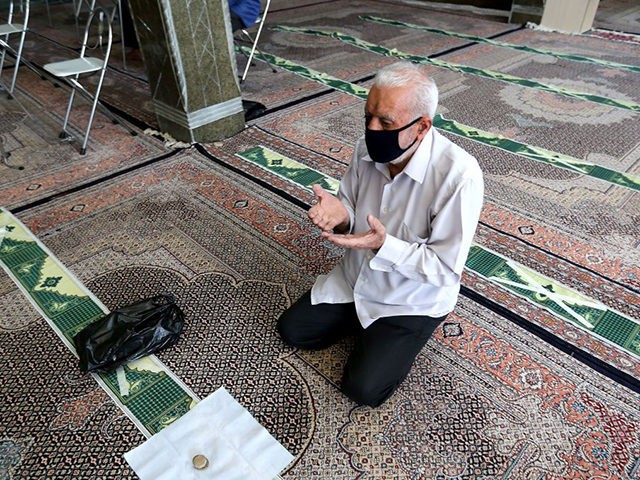The Islamist regime in Iran reported the deaths of 229 people on Tuesday as a result of the Chinese coronavirus, the highest official count in one day since the country began documenting cases in February.
Experts consider Iran’s to be one of the most severe Chinese coronavirus epidemics in the world, largely fueled by government mismanagement and encouragement of large crowds for events such as funerals. The Iranian regime claims to have officially documented 278,827 coronavirus cases at press time, among them 14,624 deaths. Iranian dissidents claim the real death toll, however, is closer to 75,000 people.
While widely considered inaccurate and distorted to favor the regime, the official death toll in Iran nonetheless suggests that the outbreak there is worsening six months into its outbreak, rather than beginning to subside given the extended period of time in which Iran has witnessed uncontrolled community transmission.
Iran’s Tasnim news agency reported Tuesday’s death toll, relayed to reporters through a Health Ministry press conference. The ministry insisted that Tehran was working diligently to document all cases, administering over two million tests nationwide. The spokesperson did not specify if Iran is using reliable test kits to confirm coronavirus cases or the homemade test kits President Hassan Rouhani claimed Iran would manufacture in February; Tehran never clarified if it ever made those kits at all.
The Iranian coronavirus outbreak began in the city of Qom, a place of holy pilgrimage for Shia Muslims and hence a tourist destination. Local officials revealed as the number of cases swelled that Islamic regime administrators in Tehran had worked to cover up the outbreak, doing little to enforce social distancing protocol adopted around the world to limit the virus’s spread. Within a month, video, and photo evidence began to surface that Iran was surreptitiously digging mass graves to hide the large number of bodies of coronavirus victims, which Iranian officials denied were legitimate, offering no counter-evidence.
As evidence of overwhelmed hospital and cemetery staff handling too many bodies mounted, the regime held a funeral for state terrorist Hossein Assadollahi, attracting thousands of people, a move that earned a rare public rebuke from Health Ministry officials. At the time, many believed the number of cases in Iran would peak in March or April given how little the government was doing to prevent the virus from spreading.
In March, World Health Organization (W.H.O.) emergency operations director Rick Brennan told reporters that the global agency believed Iran’s true coronavirus death count to be as much as five times higher than what Tehran was reporting to the world.
“We’ve said the weakest link in their chain is the data. They are rapidly increasing their ability to test and so the numbers will go up,” Brennan said after a trip to Tehran.
Iran admits that its death counts are officially peaking, the National Council of Resistance of Iran (NCRI), Iran’s largest dissident organization, reported that, by its count, 73,600 people have died of Chinese coronavirus in Iran.
“The official death count declared by the regime stands at 14,405, around a fifth of the actual figure,” NCRI noted on Monday, reflecting the W.H.O.’s prediction.
NCRI translated comments by Iranian Health Minister Saeed Namaki sounding the alarm that the situation in Iran was getting worse — despite experiencing a similar outbreak timeframe as nations like Italy and Spain, which have documented marked declines in infections.
“We are in a dangerous period. We have shortages in oxygen devices and other medical and hospital supplies. We will be having difficult days ahead of us,” Namaki said on Monday, according to an NCRI translation of official news sources.
NCRI also claimed that Rouhani said this weekend that 25 million Iranians — not 278,827 — have been infected with the Chinese coronavirus, an allegation reportedly dismissed by several Iranian officials immediately.
Iran has tried to compensate for its poor response to the virus by making unsubstantiated allegations of scientific progress, such as declaring in March that the Islamic Revolutionary Guard Corps (IRGC), a terrorist organization, was developing a Chinese coronavirus vaccine. No vaccine exists against any known type of coronavirus; the IRGC is not known to have any public health experts in its jihadist ranks. Tehran has not mentioned its alleged vaccine since the initial announcement.
Similarly, an alleged IRGC “coronavirus detector” disappearing from state media. In April, the head of the IRGC, General Hossein Salami, revealed a bizarre device he claimed used magnetic energy to find living Chinese coronavirus in patients. No scientific proof exists that such a device could work and observers noted that Salami’s detector looked uncannily similar to another fraudulent Iranian product, a fake bomb detector it once sold for a profit.
Despite the many concerns with Tehran’s public health system, Health Minister Namaki declared in May that Iran had “outperformed the most powerful countries in the fight against coronavirus.” Namaki’s underlings attributed any mistakes Iran made in responding to the crisis to faulty Chinese statistics, a rare attack against the Chinese Communist Party, typically an ally of the regime.
By July, Namaki had changed his public attitude.
“Economists should have given me a solution not to have an uprising caused by hunger and poverty,” he demanded at an emergency coronavirus meeting two weeks ago, calling Iran’s response to the crisis “embarrassing” and warning that failure to contain the virus could lead to a national “insurrection.”

COMMENTS
Please let us know if you're having issues with commenting.